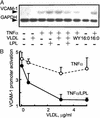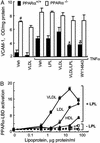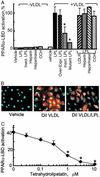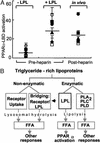Lipolysis of triglyceride-rich lipoproteins generates PPAR ligands: evidence for an antiinflammatory role for lipoprotein lipase
- PMID: 12606719
- PMCID: PMC151409
- DOI: 10.1073/pnas.0538015100
Lipolysis of triglyceride-rich lipoproteins generates PPAR ligands: evidence for an antiinflammatory role for lipoprotein lipase
Abstract
Increased levels of triglyceride-rich lipoproteins provoke lipid accumulation in the artery wall, triggering early inflammatory responses central to atherosclerosis like endothelial adhesion molecule expression. The endogenous mechanisms limiting such reactions remain poorly defined. Lipoprotein lipase (LPL) plays a central role in lipid metabolism by hydrolyzing triglyceride rich lipoproteins and releasing fatty acids. We found that LPL treatment reversed tumor necrosis factor alpha and very low-density lipoprotein (VLDL)-stimulated endothelial vascular cell adhesion molecule 1 (VCAM1) induction and VCAM1 promoter responses, thus recapitulating effects reported with synthetic peroxisome proliferator-activated receptor (PPAR) agonists. In fact, these LPL effects on VCAM1 were absent in endothelial cells isolated from PPAR alpha-deficient mice. This finding suggests a novel antiinflammatory role for LPL. Further studies reveal specificity for PPAR activation through lipolysis in regards to lipoprotein substrate (VLDL >> LDL > HDL), PPAR isoform (PPAR alpha >> PPAR delta > PPAR gamma), and among fatty acid-releasing lipases. These PPAR responses required intact LPL catalytic activity. In vivo, transgenic mice overexpressing LPL had increased peroxisome proliferation, but not in the genetic absence of PPAR alpha. Although human plasma possesses minimal PPAR alpha activation despite containing abundant free fatty acids, marked PPAR alpha activation is seen with human plasma after LPL is added in vitro or systemically released in vivo. These data suggest a previously uncharacterized pathway in which the key lipolytic enzyme LPL can act on circulating lipoproteins to generate PPAR alpha ligands, providing a potentially important link between lipoprotein metabolism and distal PPAR alpha transcriptional effects.
Figures






Similar articles
-
VLDL hydrolysis by LPL activates PPAR-alpha through generation of unbound fatty acids.J Lipid Res. 2010 Aug;51(8):2275-81. doi: 10.1194/jlr.M005561. Epub 2010 Apr 26. J Lipid Res. 2010. PMID: 20421589 Free PMC article.
-
Dual roles for lipolysis and oxidation in peroxisome proliferation-activator receptor responses to electronegative low density lipoprotein.J Biol Chem. 2003 Oct 10;278(41):39874-81. doi: 10.1074/jbc.M306786200. Epub 2003 Jul 23. J Biol Chem. 2003. PMID: 12878589 Free PMC article.
-
Enhancement of the binding of triglyceride-rich lipoproteins to the very low density lipoprotein receptor by apolipoprotein E and lipoprotein lipase.J Biol Chem. 1995 Jun 30;270(26):15747-54. doi: 10.1074/jbc.270.26.15747. J Biol Chem. 1995. PMID: 7797576
-
Role of hepatic and lipoprotein lipase in lipoprotein metabolism and atherosclerosis: studies in transgenic and knockout animal models and somatic gene transfer.Int J Tissue React. 2000;22(2-3):39-47. Int J Tissue React. 2000. PMID: 10937353 Review.
-
Postprandial lipoproteins and the molecular regulation of vascular homeostasis.Prog Lipid Res. 2013 Oct;52(4):446-64. doi: 10.1016/j.plipres.2013.06.001. Epub 2013 Jun 15. Prog Lipid Res. 2013. PMID: 23774609 Review.
Cited by
-
The vascular biology of peroxisome proliferator-activated receptors: modulation of atherosclerosis.Can J Cardiol. 2006 Feb;22 Suppl B(Suppl B):12B-17B. doi: 10.1016/s0828-282x(06)70981-3. Can J Cardiol. 2006. PMID: 16498507 Free PMC article. Review.
-
VLDL hydrolysis by LPL activates PPAR-alpha through generation of unbound fatty acids.J Lipid Res. 2010 Aug;51(8):2275-81. doi: 10.1194/jlr.M005561. Epub 2010 Apr 26. J Lipid Res. 2010. PMID: 20421589 Free PMC article.
-
Transcriptomics analysis reveals candidate genes and pathways for susceptibility or resistance to Singapore grouper iridovirus in orange-spotted grouper (Epinephelus coioides).Dev Comp Immunol. 2019 Jan;90:70-79. doi: 10.1016/j.dci.2018.09.003. Epub 2018 Sep 6. Dev Comp Immunol. 2019. PMID: 30195709 Free PMC article.
-
Triglyceride-rich lipoprotein lipolysis releases neutral and oxidized FFAs that induce endothelial cell inflammation.J Lipid Res. 2009 Feb;50(2):204-13. doi: 10.1194/jlr.M700505-JLR200. Epub 2008 Sep 23. J Lipid Res. 2009. PMID: 18812596 Free PMC article.
-
Identification and regulation of novel PPAR-gamma splice variants in human THP-1 macrophages.Biochim Biophys Acta. 2006 Jan-Feb;1759(1-2):32-43. doi: 10.1016/j.bbaexp.2006.01.005. Epub 2006 Feb 13. Biochim Biophys Acta. 2006. PMID: 16542739 Free PMC article.
References
-
- Glass C K, Witztum J L. Cell. 2001;104:503–516. - PubMed
-
- Huo Y, Ley K. Acta Physiol Scand. 2001;173:35–43. - PubMed
-
- Moers A, Fenselau S, Schrezenmeir J. Exp Clin Endocrinol Diabetes. 1997;105:35–37. - PubMed
-
- Havel R J. Proc Nutr Soc. 1997;56:659–666. - PubMed
-
- Li H, Cybulsky M I, Gimbrone M A, Jr, Libby P. Arterioscler Thromb. 1993;13:197–204. - PubMed
Publication types
MeSH terms
Substances
Grants and funding
LinkOut - more resources
Full Text Sources
Other Literature Sources
Molecular Biology Databases
Miscellaneous

